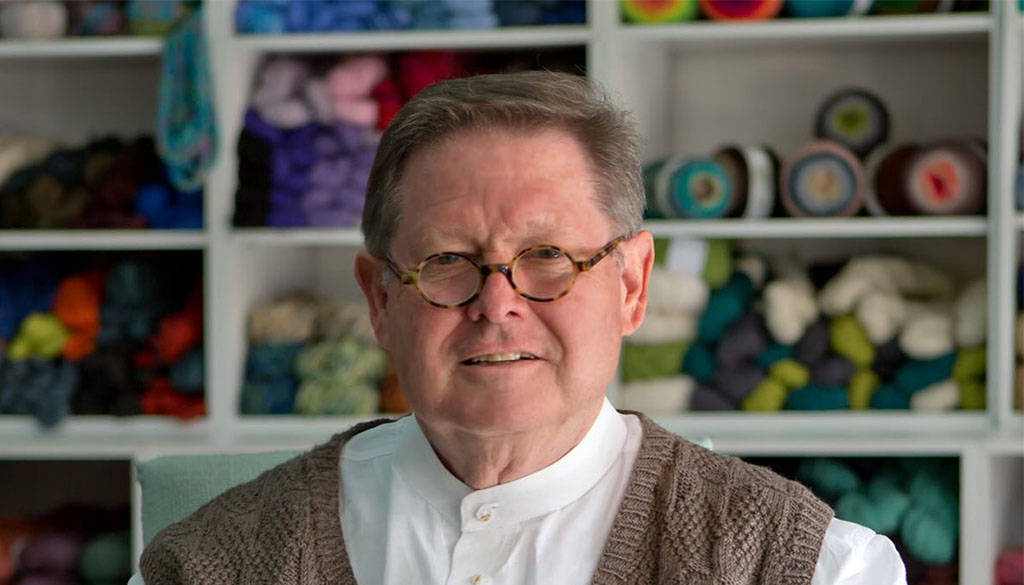
06 Mar Beyond the Sock with Master Knitter Charles D. Gandy
We are lucky to have TKGA Master Knitter Charles D. Gandy teach regularly at the Folk School. I sat down with him in the Wet Room Studio during a class where students were working on fantastic knitted pieces like vegetable gardens, jonquils, and Pop Art-esque Campbell’s soup cans. Charles learned to knit at the young age of four from his mother, a designer and shop owner. He designed his first sweater three years later and continues to create today. Let’s find out a little bit more about Charles D. Gandy.
Notice: This Class Has Passed. Please check out our other Knitting classes.
CP: Your designs are just wild; I love them! Where do you find inspiration?
CG: We’ve been talking a lot about that here in class. I find a lot of inspiration in nature. For example, today I looked outside and saw a tree and I thought, “Look at those leaves hanging on that tree? Wouldn’t that make a fun sock?”
I look at things and I listen to things (like your banjo playing this morning). I was on a hike earlier this year and there were icicles hanging on a rock wall, so I made a note to do something with icicles. Sometimes it’s a person, sometimes it’s a yarn, or sometimes it’s a just moment where I will find inspiration.
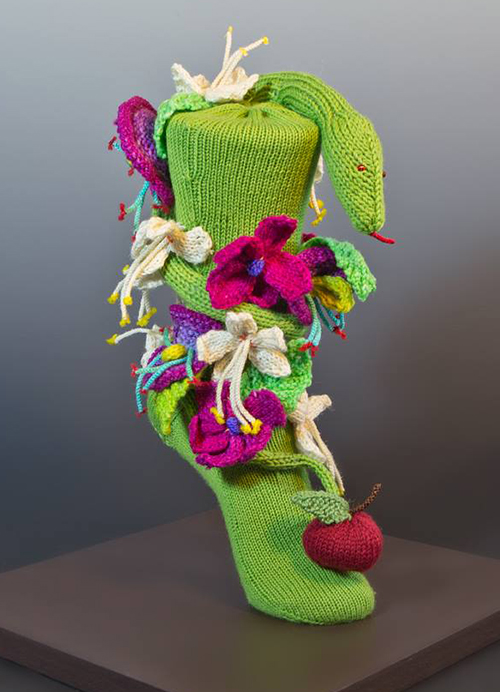
Garden of Eden Sock. Photo by Peter McIntosh.
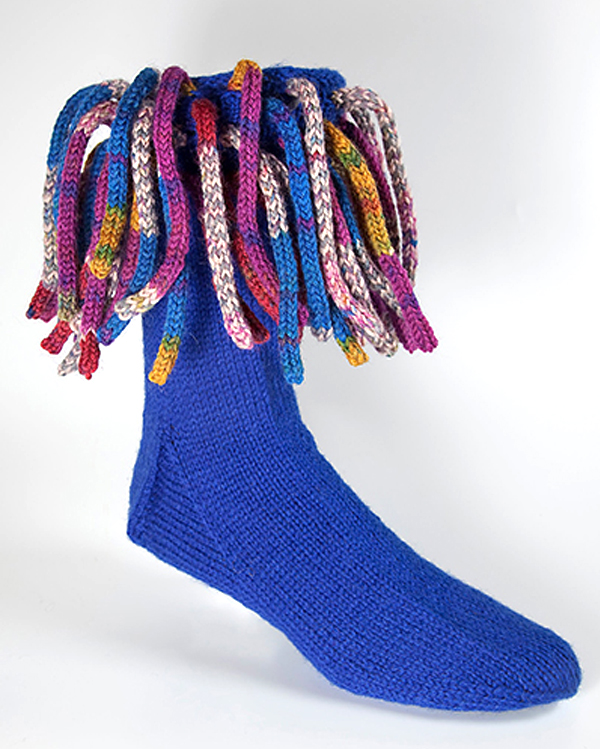
Dread Sox
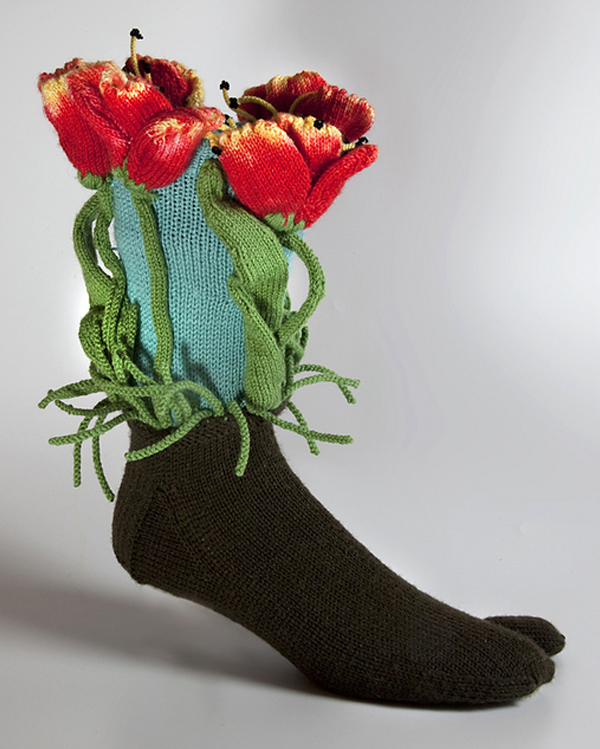
Tulips Socks
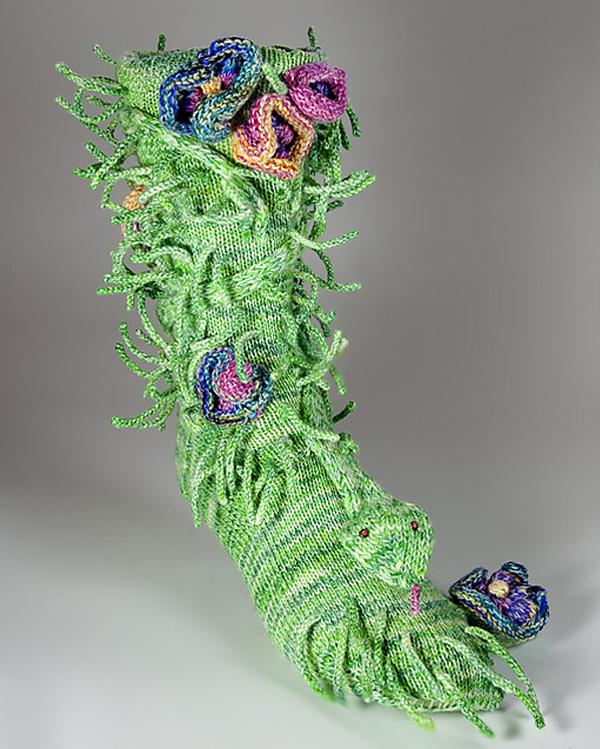
Snakes in the Grass Socks
CP: Let’s talk about socks, the focus of your book, The Embellished Sock: Knitted Art for the Foot. Why socks?
CG: My book came as result I entered of a contest I entered: “Think Outside the Sox.” Twenty-five yarn manufacturers sponsored the competition. Each company wrote a paragraph about a project they were interested in seeing their specific yarn used for. You could enter up to five pairs of socks and some of the proposals immediately spoke to me. One of the ones that hit me was the idea of a snake in the grass. I started thinking, “How can I realize that?” Three of my designs (Dread Sox, Snake in the Grass and Pedicure Polka Socks) were winners and are featured in the book of the same name.
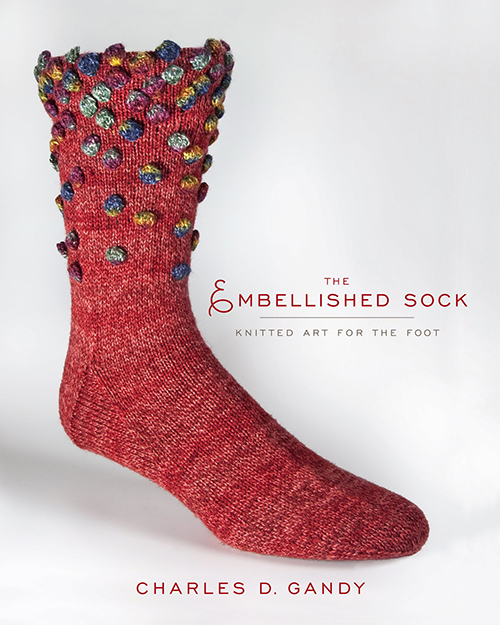
The Embellished Sock Book Cover
CP: Tell me about the sock on the cover.
CG: It is called “Pebbles.” I was sitting on the patio of a friend’s house one fall day and the leaves had blown up against the patio. You know how leaves kind of gather up and scatter back out? That inspired me to do a sock with leaves. In the development stage, I had an idea of using baubles as embellishment, and then it went from being leaves to pebbles.
I do other designs besides socks. Sweaters are a prime example. I also do lots of toys, hats, mittens, ornaments, and more. I’ve become known for socks because I published the book. Socks are a fun way to push the envelope of form and function.
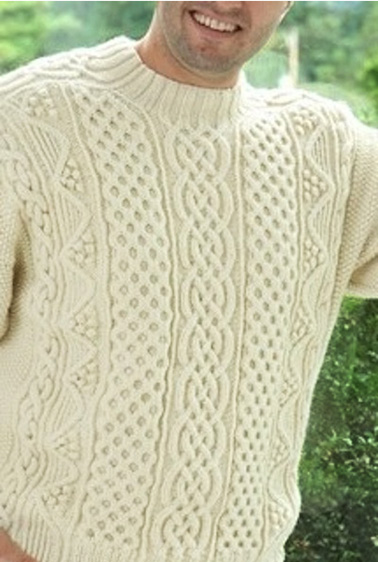
Sweater Close Up
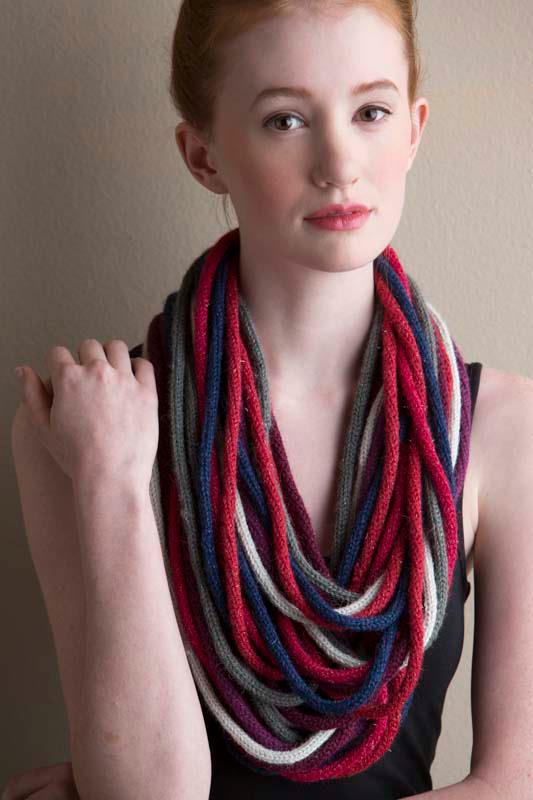
Neckwear
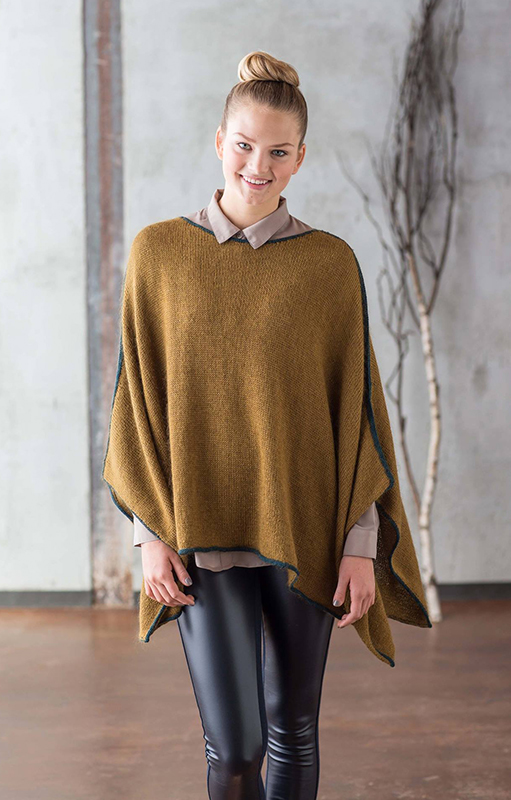
Poncho Design
CP: In addition to nature, I noticed world destinations are an inspiration for your work. I noticed your Icelandic-inspired Hallgrim hat for example?
CG: Oh the Hallgrim Hat! I have traveled a lot and that was a pattern based on my trip to Reykjavík, Iceland. There is an iconic church in Reykjavík called the Hallgrim church. Anybody who has been to Reykjavík has seen that church; it’s right in the middle of town, you can’t miss it. That hat has been the most popular pattern I’ve ever written. If you look at that hat, you don’t have to know that it’s from that church, but you know it’s a nice design. Do you like it?
CP: Oh, yes! I love the design and then finding out the backstory about your inspiration is an added treat.
CG: It’s a pretty design, and when you see the church, you see the church in the hat. When I travel, I keep a sketchbook with me to record details of what I see. I once spent three days on the floors of St. Mark’s cathedral in Venice sketching the mosaic tile patterns. I have sketchbooks that date back for 40 years where I’ve cataloged colors and ideas.
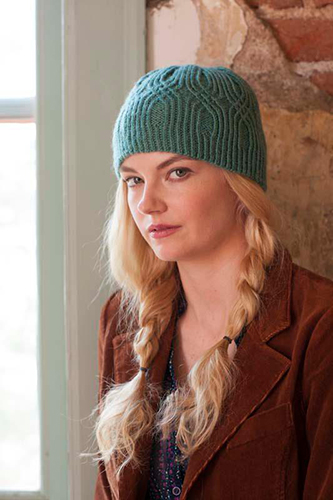
Hallgrim Hat
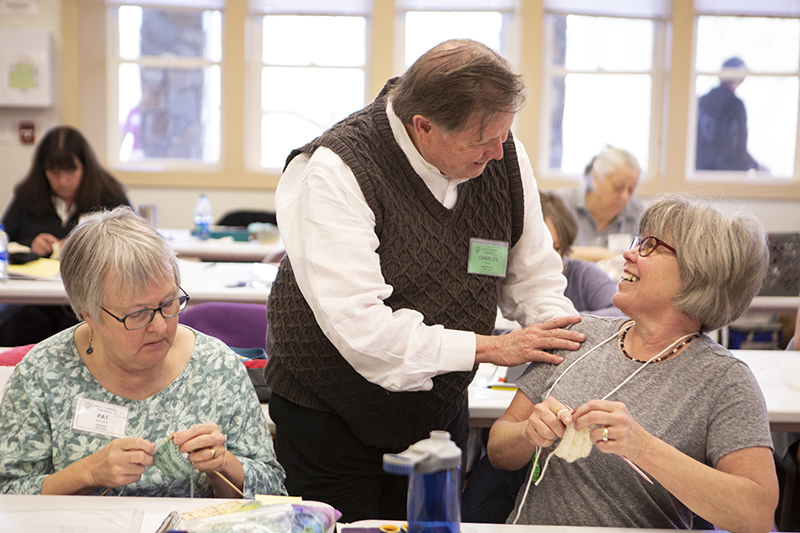
Charles Teaching Class in Our Wet Room Studio
CP: What is your class focus this week?
CG: Part of what we’re doing here in this class is learning and adding tools to our design toolboxes. Students are learning all kinds of different techniques so when they get these ideas to do projects, then they can go back to their toolbox and figure out a planned to accomplish their design goals. The more little tricks you know, the more prepared you will be to create your own designs when you find inspiration.
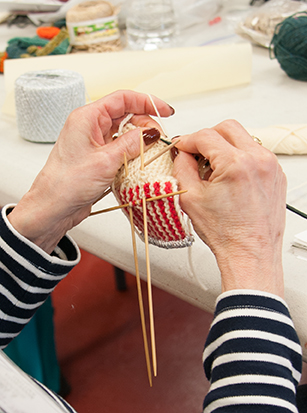
A student in class takes some inspiration from Warhol and knits a Campbell’s soup can.
CP: Tell me more about your upcoming class” Expanding Your Knitting: Beyond the Basics” and its specific technique or process.
CG: This class is for anyone that is comfortable with knitting and purling but needs a boost to go to the next level. From various cast ons and bind offs, decreases and increases, basic lace, basic cabling…. finishing and embellishing combined with tons of tips and tricks, all will be explored.
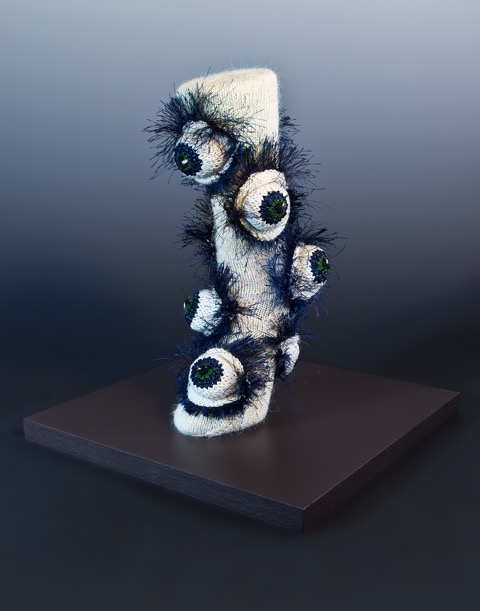
“The Eyes of March”
CP: Do you like to plan projects out and design on paper or is it more experimentation and happy accidents?
CG: It’s a combination of all of the above. I will get an idea and let it mull around in my head for a while. I’ll think through how I am technically going to execute it and what kind of yarns should I use. I sketch by knitting samples and I try them out to see what works and what doesn’t work.
A design I worked on for a show is called, “The Eyes of March,” and it’s a sock covered with three-dimensional eyes. I have been collecting tons of images of very simple eyes. I spend a lot of time practicing and making swatches and samples. The actual final knitted project is the least time of what I do. Most of it is sketching and testing.
CP: What’s the most meaningful piece you have ever made?
CG: What a great question! Hmmmm. Maybe it’s the first thing I ever designed, which was when I was seven years old. I learned to knit from my mother when I was four or five and I have the first sweater I ever designed when I was seven. It buttons down the front, and it buttons down the back. It is a half sweater and it was designed to help use up bits and pieces of yarn. My mother had a shop and yarn shops always have one or two skeins of yarn left. This sweater was a way to help those bits and piece of yarn. I still have that sweater, so I think that’s the most meaningful piece.
CP: Where did you grow up?
CG: I grew up in Alabama. I went to Auburn University. I have a degree from the school of architecture. I graduated and I practiced interior design for 40 years. I was the national president of our professional organization and I was very successful as an interior designer. While I designed interiors I was very involved with fiber. I have a minor degree in weaving. I was always knitting, weaving, and needle pointing. I also served for seven years on the Board of Trustees for the American Craft Council, so I’ve been always involved with fiber and craft.
CP: How has your extensive experience in interior design informed and influenced your fiber art?
CG: Design is design, so my interior design experience has helped me with my design in knitting: proportion, scale, rhythm, balance, and all of that are the same whether I’m knitting or whether I’m designing an interior.
For over 10 years, I have been concentrating exclusively on my fiber art. I left my design practice and then the sock contest came along. Shortly after that, I got involved with TKGA (The Knitting Guild Association) and I enrolled in the Master Knitting Program and I became one of 350 Master Knitters (of only 10-12 who are men). I now serve on the Master Knitting committee. It’s very hard program to complete and I am very proud of it. I’ve been knitting for 70 years and I still learned a lot!
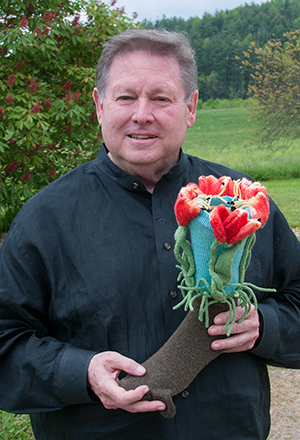
Charles Holding His Tulip Sock
CP: What was it like growing up as a boy who knit?
CG: I learned to knit at age 4, and when I started school in the 1st grade, I was surprised that everyone didn’t knit! People always ask me, “Weren’t you bullied?” I don’t remember being bullied. To some extent, I think to be bullied, you need to allow yourself to be bullied. If they bullied me, it didn’t last long, because it didn’t bother me. My father didn’t care that I loved to knit. I’ve always loved being around fiber.
CP: Are there a lot of men who knit?
CG: Knitting actually first started as a man’s profession. It’s almost easier to gain a reputation and notoriety as a male knitter because it’s unexpected and people will remember you. I know a lot of male knitters and the number is always increasing. I could name 15-20 very well known male designers. I was in Pittsburgh teaching this year at a conference and there were 4000 people there. I would bet that 10% of those 4000 were men.
There’s still some prejudice about it. There was a writer who interviewed me recently about being a male knitter. She started out by asking, “Are most knitters women because men’s hands are so clumsy?” I had to get on her case about it and point out her gender bias, so I asked her, “Aren’t most surgeons men? Are their hands clumsy?”
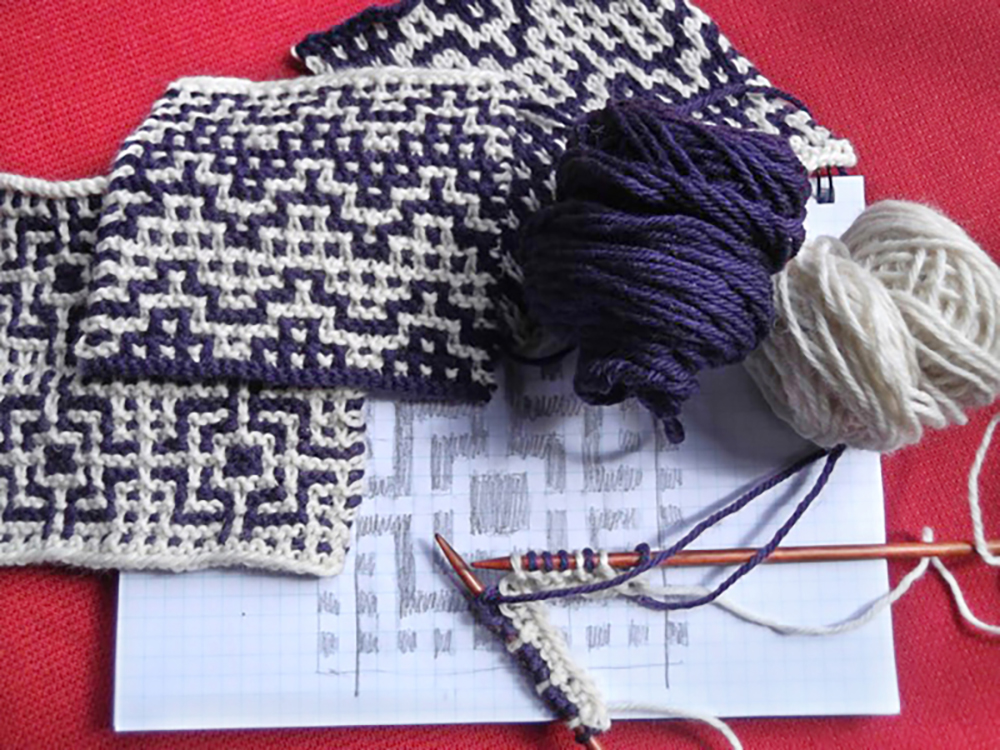
Mosaic Knitting
CP: How long have you been teaching at the Folk School?
CG: I’ve been teaching at the Folk School since around 2010. The first time I came, I took a knitting class and met Martha Owen. I knew right away I’d like to teach at the Folk School and this was when I was working on my book. Martha and I decided to try it and I’ve been coming back ever since.
CP: What do you like about teaching at the Folk School?
CG: I love the enthusiasm of the students and I’ve always had a really good experience at the Folk School. People come here because they are eager and anxious to learn. I like the non-competitive philosophy and the “camp for adults” atmosphere.
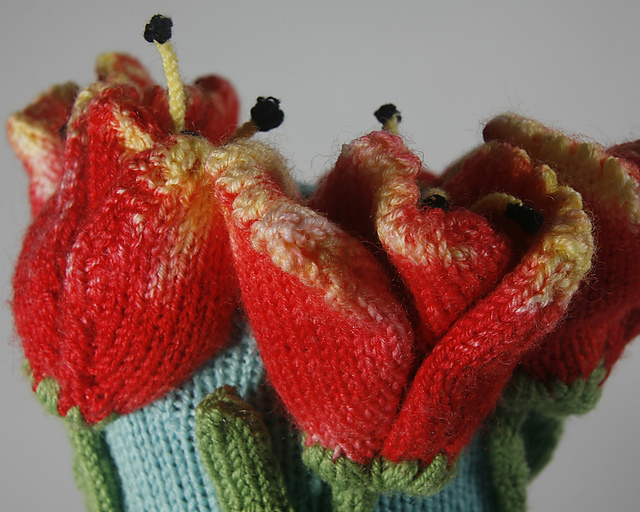
CP: What can students expect to leave your class with?
CG: An exciting weeklong gathering will unfold full of learning, friendship and fellowship.
CP: What tips would you give a student or aspiring craftsperson? Anything you wish you had known earlier in your career?
CG: Relax…learn the basics…then do your own thing!
JCCFS: Where can folks find you if they want to stay up to date on your work?
CG: Follow me on Facebook an on ravelry.com as charlesgandyknits.
Upcoming Classes with Charles D. Gandy
Expanding Your Knitting Techniques
Do you know how to knit and purl comfortably but wonder what could be next? Learn different cast-ons and bind-offs, increases and decreases, simple cables and lace, and maybe a bobble or two—plus tons of tips and tricks. Finish the week learning how to seam like a pro. This fun experience will springboard your knitting far beyond the basics. Advanced beginners and above welcome. Learn more
Notice: This Class Has Passed. Please check out our other Knitting classes.
Mosaic Knitting
Mosaic knitting is a form of multicolor knitting developed by famed author and historian, Barbara G. Walker. In this fun technique, only one color of yarn is used in any row, but stitches from the previous row are slipped, generating complicated-looking, two-color patterns. Anyone who knows how to knit and purl can quickly learn to create these striking patterns. Return home with a variety of samples for future reference. Learn more.
Notice: This Class Has Passed. Please check out our other Knitting classes.
About Charles D. Gandy
CHARLES D. GANDY, a TKGA Master Knitter, learned to knit at the age of four from his mother, a designer and shop owner. A two-time winner in Knitter’s Magazine “Think Outside the Sox” contest, three of his designs are featured in the book of the same name: “Dread Sox”, “Snake in the Grass” and “Pedicure Polka Socks”. His own book, The Embellished Sock: Knitted Art for the Foot features eighteen creative patterns and numerous techniques and is available in yarn shops worldwide. His latest collections “Crazy Socks” and “MORE Crazy Socks” for REGIA Yarns have been received worldwide. He is a popular teacher at workshops and conferences worldwide. BEYOND THE SOCK, Knitted Art by Charles Gandy, featuring 28 one-of-a-kind sculptural socks was shown at The Bascom, A Center for The Arts in Highlands, NC from March 12–June 12, 2016. His work placed as a semi-finalist in the 28th Annual World of Wearable Art in Wellington, New Zealand and later was on display at the 7th Wearable Expressions at the Palos Verdes Art Center in California. In February of 2022, HIDDEN FACES: Knitted Masks premiered at Atlanta’s Signature Contemporary Crafts Gallery.



Ashley Kiefer
Posted at 13:54h, 04 SeptemberTell Charles Hello for me! I loved meeting him when we took the German Lace Knitting class together a couple years back.
Cory Marie Podielski
Posted at 11:23h, 05 SeptemberWill do Ashley! He’s coming to the Folk School this upcoming week to take a class, so I will definitely say hello for you 😉
Jo Ann Vicarel
Posted at 10:45h, 05 SeptemberWhat a great interview. Just when I think that there is nothing new under the knitting needles I see the socks by Charles Gandy. As a knitter of many years and a teacher of knitting, a subscriber of many knitting magazines, websites and owner of a large collection of knitting books, it is amazing to see Mr. Gandy’s beautiful and creative designs. There are still some people who think that only little old ladies sitting around in English villages knitting and solving murder mysteries are the only people who knit. For those of us who know better, we know that all ages have taken up their needles to create wonderful items to give as gifts or to wear with the pride and pleasure of showing off something made by one’s own hand. Thank you for including an interview in your newsletter. Great job all the way around.
Cory Marie Podielski
Posted at 11:23h, 05 SeptemberThanks for your lovely comment! It’s always nice to hear that folks are enjoying the interview. 😉
Suzanne
Posted at 18:39h, 05 SeptemberAwesome interview! Thanks.